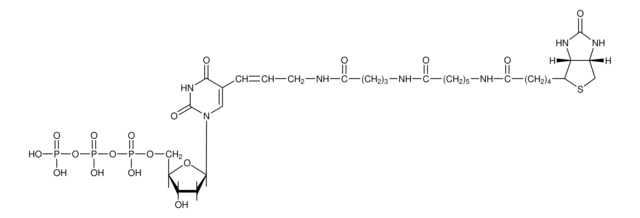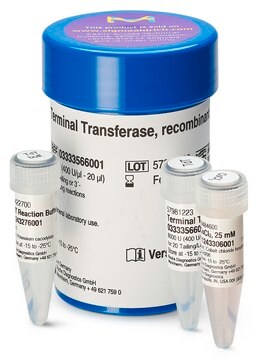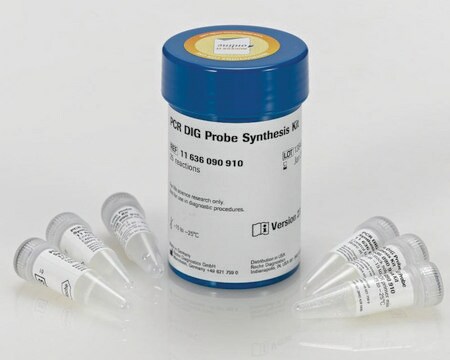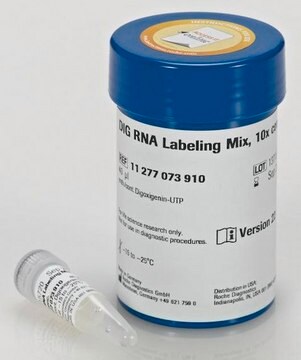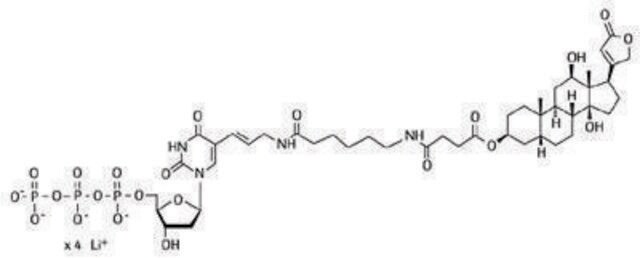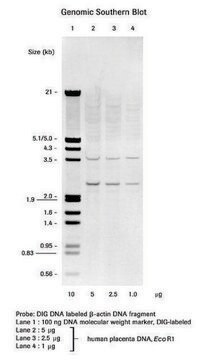DIUTP-RO
Roche
Digoxigenin-11-dUTP, alkali-labile
=85% (HPLC), solution, pkg of 25 μL (11573152910 [1 mM]), pkg of 125 μL (11573179910 [1 mM]]])
Synonym(s):
Digoxigenin-11-dUTP, alkali-labile, digoxigenin
Sign Into View Organizational & Contract Pricing
All Photos(1)
About This Item
UNSPSC Code:
41105500
Recommended Products
Quality Level
Assay
85% (HPLC)
form
solution
packaging
pkg of 125 μL (11573179910 [1 mM]]])
pkg of 25 μL (11573152910 [1 mM])
manufacturer/tradename
Roche
storage temp.
−20°C
Looking for similar products? Visit Product Comparison Guide
General description
Digoxigenin (DIG)-11-deoxyuridine triphosphate (dUTP), alkali-labile is provided as in 1 mM tetralithium salt, solution. In which DIG is bound to dUTP via an alkali-sensitive ester linkage.
Application
Digoxigenin-11-dUTP, alkali-labile can be used for non-radioactive DNA labeling e.g. random primed or nick translation. It can also be used for labeling probes which are preferred in hybridization experiments where stripping and reprobing of the membrane is intended.
Biochem/physiol Actions
Digoxigenin (DIG)-11-deoxyuridine triphosphate (dUTP) replaces deoxythymidine triphophate (dTTP) in the random-primed DNA labeling reaction or in nick translation in a ratio of 35% DIG-11-dUTP and 65% dTTP. It is ideal as a substrate for DNA polymerase, Taq DNA polymerase, terminal transferase and reverse transcriptase.
Other Notes
For life science research only. Not for use in diagnostic procedures.
When this nucleotide is subjected to 0.1 - 0.5 NaOH at +15 to +25°C, the DIG moiety will be removed. It is therefore ideal for use in DIG-labeled probes that can be removed by alkali denaturation (e.g ., in stripping and reprobing of blots). However, if you intend to make a DIG-labeled DNA that will survive alkaline treatment, do not use this alkali-labile preparation. Instead, use the alkali-stable form of DIG-11-dUTP.
When this nucleotide is subjected to 0.1 - 0.5 NaOH at +15 to +25°C, the DIG moiety will be removed. It is therefore ideal for use in DIG-labeled probes that can be removed by alkali denaturation (e.g ., in stripping and reprobing of blots). However, if you intend to make a DIG-labeled DNA that will survive alkaline treatment, do not use this alkali-labile preparation. Instead, use the alkali-stable form of DIG-11-dUTP.
also commonly purchased with this product
Product No.
Description
Pricing
Storage Class Code
12 - Non Combustible Liquids
WGK
nwg
Flash Point(F)
does not flash
Flash Point(C)
does not flash
Choose from one of the most recent versions:
Already Own This Product?
Find documentation for the products that you have recently purchased in the Document Library.
Customers Also Viewed
James E Dombrowski et al.
BMC research notes, 4, 46-46 (2011-03-08)
Choke, caused by the endophytic fungus Epichloë typhina, is an important disease affecting orchardgrass (Dactylis glomerata L.) seed production in the Willamette Valley. Little is known concerning the conditions necessary for successful infection of orchardgrass by E. typhina. Detection of
Interstitial telomeric sequence blocks in constitutive pericentromeric heterochromatin from Pyrgomorpha conica (Orthoptera) are enriched in constitutive alkali-labile sites
Lopez-Fernandez, Carmen, et al
Mutation Research. Fundamental and Molecular Mechanisms of Mutagenesis, 599 (1), 36-44 (2006)
Araceli Nora García et al.
BMC plant biology, 14, 248-248 (2014-09-18)
The production of antimicrobial peptides is a common defense strategy of living cells against a wide range of pathogens. Plant snakin peptides inhibit bacterial and fungal growth at extremely low concentrations. However, little is known of their molecular and ecological
Sara Bembich et al.
Nucleic acids research, 42(5), 3362-3371 (2013-12-27)
TDP-43 is a nuclear protein involved in many aspects of RNA metabolism. To ensure cellular viability, its expression levels within cells must be tightly regulated. We have previously demonstrated that TDP-43 autoregulation occurs through the activation of a normally silent
Eric Röttinger et al.
PLoS genetics, 8(12), e1003164-e1003164 (2013-01-10)
Understanding the functional relationship between intracellular factors and extracellular signals is required for reconstructing gene regulatory networks (GRN) involved in complex biological processes. One of the best-studied bilaterian GRNs describes endomesoderm specification and predicts that both mesoderm and endoderm arose
Our team of scientists has experience in all areas of research including Life Science, Material Science, Chemical Synthesis, Chromatography, Analytical and many others.
Contact Technical Service
